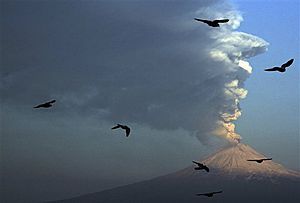
Steam, smoke and hot fragments of rock began to be ejected from Popocatepetl this past weekend.
The volcano is located about 50 miles southeast of Mexico's capital, Mexico City. The metropolitan area of Mexico City is home to approximately 21 million people.
According to Reuters, Mexico's National Center for Disaster Prevention this week raised the alert level to three on a scale from one to seven, with seven being the greatest threat.
If eruptions intensify, evacuations of nearby villages may be necessary.
The volcano has had a long history of frequent minor to moderate eruptions.
In 2000, thousands of residents surrounding the nearly 18,000-foot mountain were forced to evacuate. Popocatepetl is North America's second highest volcano.
Eruptions have occurred in November and June of 2011.
According to VolcanoDiscovery.com, Popocatepetl was dormant during the 1950s, 60s, 70s and 80s.
This is a very active volcanic region of the globe and is known as the Trans-Mexican Volcanic Belt.
Mexico authorities were recommending limiting access to the area, including air travel due to the frequency of the volcanic activity of late.
Ash from volcanoes can be carried into the intake of engines, leading to failure.
During a major eruption, smoke and ash can be carried for hundreds and thousands of miles downwind, depending on weather conditions. Such was the case with Eyjafjallajokull in Iceland during 2010.
Accord to Smithsonian, the last major eruption of Popocatepetl, which including a pyroclastic flow, occurred around 800 AD.
A pyroclastic flow is a combination of lethal hot gas and ash, similar to what happened in Pompeii, Italy.
Popocatepetl is the Aztec word for smoking mountain.
Surface winds in the vicinity of the volcano during April 19, 2012, were generally from the west and northwest, carrying smoke and ash away from the Mexico capital.
The town of Puebla, located southeast of Popocatepetl was reporting volcanic ash in the vicinity for a few hours during April 18.
This story was first published on Monday, April 16, 2012 and has been updated.



Reader Comments
to our Newsletter